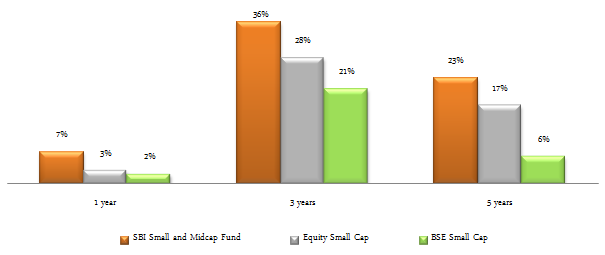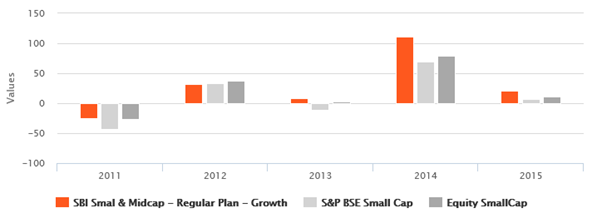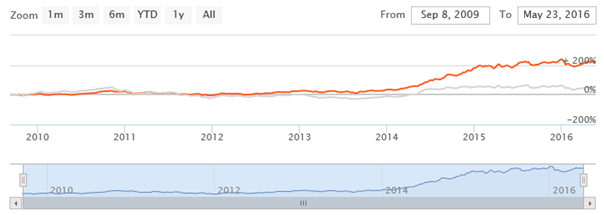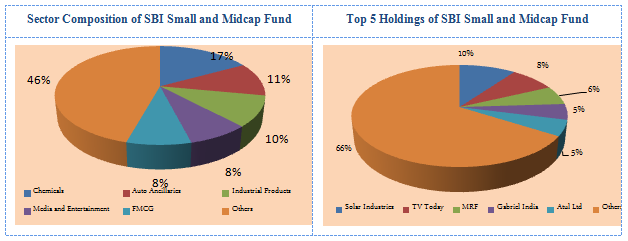SBI Small and Midcap Fund: One of the Best Midcap Mutual Funds for SIP in last 5 years

If you started a monthly SIP of र 5,000 in SBI Small and Midcap Fund 5 years back, your investment value would have been over र 6.31 lacs by May 23, 2016 (Source: Advisorkhoj Research). In other words, you would have made a profit of र 3.3 lacs, on a cumulative investment of र 3 lacs. The annualized SIP return of the fund in the last 5 years was over 31%. While 30%+ returns over a 5 year period is extraordinary by any standard, what makes the performance of this fund even more admirable is the fact that, the equity market in the last 5 years has been quite volatile and saw two bear market phases, one in 2011 and the another in 2015 – 2016.
The SBI Small and Midcap Fund has always been among the top 3 small and midcap equity mutual funds in terms of SIP returns in the last 3 to 5 years (please see top performing midcap funds for SIP in our MF Research section, Top Performing Systematic Investment Plan - Equity Funds Mid and Small Cap).
Fund Overview of SBI Small and Midcap Fund
SBI Mutual Fund is the second oldest Asset Management Company in India. In fact SBI Mutual fund was established in 1987 and was the first non UTI mutual fund house in the country. SBI mutual fund schemes have a strong track record of performance across multiple categories over the last two or three decades. SBI Small and Midcap Fund, however, is a relatively younger fund, launched in September 2009. It has an AUM base of र 757 crores.
A relatively smaller AUM base is often an advantage for equity mutual funds in the small and midcap space. A large AUM size often becomes a handicap for small and midcap funds, because the free float stocks (i.e. the non promoter holdings) is limited in the small and midcap space. Therefore, if the AUM of a small/midcap fund grows beyond a size, the investment opportunities become quite limited and they are forced to invest in large cap stocks. From an AUM perspective therefore, SBI Small and Midcap fund has an advantage relative to bigger sized small / midcap funds. Despite the relatively smaller sized AUM, the expense ratio of SBI Small and Midcap fund is just 2.38%. R. Srinivasan is the fund manager of SBI Small and Midcap Fund. The fund has given over 19% compounded annual returns since inception.
The chart below shows the annualized trailing returns of SBI Small and Midcap fund over the last 1, 3 and 5 years, versus the category and the benchmark (NAVs as on May 23, 2016).

Source: Advisorkhoj Research
You can see that SBI Small and Midcap Fund outperformed the category and the benchmark, BSE Small Cap Index across all time-scales.
The chart below shows the annual returns of SBI Small and Midcap fund versus the category and the benchmark, over the last 5 years.

Source: Advisorkhoj Research
The chart below shows the NAV movement of SBI Small and Midcap Fund since inception.

Source: Advisorkhoj Research
Rolling Returns of SBI Small and Midcap Fund
Rolling returns are the annualized returns of the scheme taken for a specified period (rolling returns period) on every day and taken till the last day of the duration. In this chart we are showing the annualized returns over the rolling returns period of 3 years on every day from the inception date and comparing it with the benchmark. We have chosen a 3 years rolling returns period, because we believe an investor needs to have a sufficiently long time horizon (minimum of 3 years) when investing in equity funds.
Rolling returns is the best measure of a fund's performance. Trailing returns have a recency bias and point to point returns are specific to the period in consideration. Rolling returns, on the other hand, measures the fund's absolute and relative performance across all timescales. The orange line in the chart below shows the three year rolling returns of SBI Small and Midcap Fund since inception, while the black line shows the three year rolling returns of the benchmark, BSE Small Cap Index.

Source: Advisorkhoj Research
You can see that, the 3 year rolling returns of the SBI Small and Midcap Fund has been more than 25%, over 90% of the times since inception. This is indeed a remarkable performance, given that the market conditions over the past 6 – 7 years have been mixed. You can also see that the fund has beaten the benchmark index 100% of the times, an indicator of strong fund management. Finally, readers should notice that the gaps in 3 year rolling returns of the fund and benchmark are very stable, since inception. This shows that a structured portfolio management methodology is employed by the fund manager. This is also an evidence of prudent risk management practises followed by the fund manager.
Portfolio Construction of SBI Small and Midcap Fund
The fund portfolio has a small cap bias and the investment style of the fund manager is growth oriented. The fund portfolio is overweight on cyclical sectors like Chemicals, Auto Ancillaries, Industrial Products, Media and Entertainment and Consumer Durables. From a company concentration perspective the portfolio is well diversified, with the top 5 holdings, Solar Industries, TV Today, MRF, Gabriel India and Atul Limited accounting for 34% of the portfolio value.

Source: Advisorkhoj Research
Risk and Return of SBI Small and Midcap Fund
From a risk perspective, the volatility of SBI Small and Midcap Fund is on the lower side relative to the category. Since, the fund has outperformed the category in terms of returns it implies that the risk adjusted performance of the fund is outstanding. As such the Sharpe Ratio of the fund is much higher than that of the category.
The chart below shows the growth of र 1 lac investment in SBI Small and Midcap Fund (growth option) at the time of the NFO (based on NAVs as on May 23, 2016).

Source: Advisorkhoj Research
You can see in the chart above that your र 1 lac in the NFO of the fund would have grown to nearly र 3.25 lacs (3 times returns in the last 5 years), as shown by the orange line. The same amount invested in the benchmark would have grown to less than half the amount of SBI Small and Midcap Fund, as shown by the grey line.
The chart below shows the return of र 5,000 monthly SIP in SBI Small and Midcap Fund (growth option), since the inception of the fund (NAVs as on May 23, 2016).

Source: Advisorkhoj Research
You can see that, a र 5,000 monthly SIP in SBI Small and Midcap Fund (growth option), since the inception of the fund, would have grown to over र 9.4 lacs, while the cumulative investment would have been little over र 4 lacs. SBI Small and Midcap Fund has indeed been a wealth creator over the last 6 to 7 years.
Conclusion
SBI Small and Midcap Fund has delivered strong performance over the last 6 – 7 years. Investors need to have a long investment horizon, for investing in this fund. However, like with any other small and midcap fund, investors need to be prepared for volatility. Here, you may like to read – Protection from volatile markets Investors can take advantage of volatility through rupee cost averaging by investing through SIP. Investors should consult with their financial advisors, if SBI Small and Midcap Fund is suitable for their investment needs.
(The fund is currently not open for fresh subscriptions. However, the existing unit holders will continue with their respective SIP investments till end of the SIP tenure)
Mutual Fund Investments are subject to market risk, read all scheme related documents carefully.
Queries
-
What is the benefit of mutual fund STP
Aug 29, 2019
-
How much to invest to meet target amount of Rs 2 Crores
Aug 26, 2019
-
Can I achieve my financial goals with my current mutual fund investments
Aug 24, 2019
-
Can you tell me return of various indices
Aug 19, 2019
-
What would be the post tax return on different investments
Aug 18, 2019
-
Which Principal Mutual Fund scheme will be suitable for my retirement corpus
Aug 16, 2019
-
What is the minimum holding period for availing NCD interest
Aug 4, 2019
Top Performing Mutual Funds
Recommended Reading
Fund News
-
Zerodha Mutual Fund launches Zerodha Nifty Short Duration G Sec Index Fund
Dec 26, 2025 by Advisorkhoj Team
-
Groww Mutual Fund launches Groww Nifty Chemicals ETF
Dec 26, 2025 by Advisorkhoj Team
-
DSP Mutual Fund launches DSP Nifty Next 50 ETF
Dec 19, 2025 by Advisorkhoj Team
-
DSP Mutual Fund launches DSP Nifty 500 Index Fund
Dec 19, 2025 by Advisorkhoj Team
-
Kotak Mahindra Mutual Fund launches Kotak Nifty Next 50 ETF
Dec 18, 2025 by Advisorkhoj Team














